In Q2 2016, the Chinese listed fluorochemical companies successively released
their full-year 2015 financial reports. In order to make it clear about the
industry status quo and development trend, CCM specifically selected 4 listed companies to make systematic analysis.
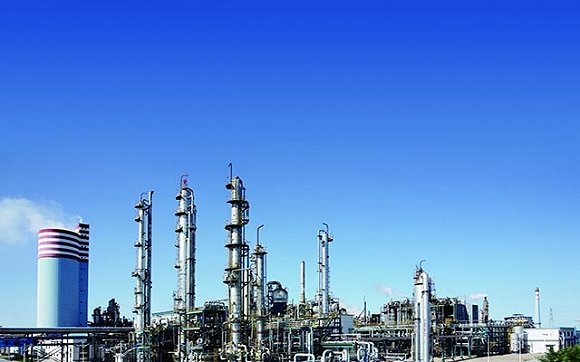
Source: Internet
In Q2 2016, the Chinese listed fluorochemical companies successively released
their full-year 2015 financial reports. Accordingly, most of the companies
reversed the declines and stabilised their performances. In particular, some
companies achieved significant growths in profit, since they continuously
carried out transformation and upgrading, including product structure
optimisation (into downstream deep processing), new/ modified material development
and new application exploitation. For instance, Do-Fluoride Chemicals Co., Ltd.
(Do-Fluoride) and Zhejiang Yongtai Technology Co., Ltd. (Zhejiang Yongtai)
recorded a rise of 310.51% and 72.69% YoY in net profit.
In order to make it clear about the domestic fluorochemical industry status quo
and development trend, analyst CCM specifically selected 4 leading listed
companies to make analysis on their financial figures in 2013-2015, with regard
to the overall performance, profit, assets, debt risk, R&D input and
projects under construction.
The 4 companies are Do-Fluoride, Shanghai 3F New Materials Co., Ltd. (Shanghai
3F), Zhejiang Juhua Co., Ltd. (Zhejiang Juhua) and Zhejiang Yongtai.
I Overall performance
1. Revenue growth rate (fluorochemical business only)
Zhejiang Juhua and Zhejiang Yongtai realised considerable growths in 2015, by
4.43% and 20.27% YoY respectively, signalling rises in 2 consecutive years. By
contrast, Shanghai 3F and Do-Fluoride showed negative results, by -1.24% and
-0.03%. Notably, Do-Fluoride improved significantly compared to -5.24% in 2014.
This to certain extent meant that the domestic fluorochemical industry was
recovering in 2015.
Specifically,
- Zhejiang Yongtai: thanks to the rises in sales from fluorine-enriched
refrigerants (up by 13.76%) and fine fluorochemicals (up by 7.52%)
-
Fluorine-enriched refrigerants: combined sales volume up by
11.07%, due to the substantial rises in sales volumes of refrigerant
mixes, HFC-125, HFC-134a aerosol can, etc. Note: refrigerant mixes
involved R410a (a mixture of difluoromethane – HFC-32 and
pentafluoroethane – HFC-125), R404A (a mixture of HFC-125,
1,1,1,2-tetrafluoroethane – HFC-134a and trifluoroethane – HFC-143a), and
R407C (a mixture of HFC-32, HFC-125 and HFC-134a)
-
Fine fluorochemicals: combined sales volume up by 45.16%, owing
to the strong demands for 2-bromoheptafluoropropane and suchlike
- Zhejiang Yongtai: mainly involved in fine chemicals business
(specifically the fluorobenzene series), comprising 3 categories based on
different applications, namely agrochemicals, pharmaceutical chemicals and
liquid crystal chemicals.
In the context that the downstream industries went up continuously, the company
vigorously expanded the market at home and abroad, by largely improving the
production and sales scales. In 2015, the said 3 product categories recorded a
rise of 2.05%, 20.15% and 29.52% separately in sales. The combined output and
sales volume was up by 17.78% and 16.01% respectively.
2. Capital maintenance and increment ratio
The 4 listed fluorochemical companies attained certain increases. Of this,
Zhejiang Yongtai recorded the highest, at 136.49%, whilst Zhejiang Juhua
maintained the lowest, at 102.63%, despite the growth from 92.82% in 2014. This
indicated that Zhejiang Juhua, in recent two years, has fallen behind in
capital maintenance and shareholder equity growth.
According to CCM’s research, Zhejiang Juhua made the rise by:
-
Giving full play to its advantages in supply chain, scaled
technology, brand and sales channels, to expand the market and finally
stabilise the operation of main business
-
Carrying out secondary innovation on production facilities and
management innovation, including cutting down the number of staff, saving
energy, decreasing consumption, improving rate of quality product, and
levelling up labour productivity, to finally reduce costs and raise efficiencies,
promote efficiency of stock assets and enhance competitiveness
Notably, the new projects launched by Zhejiang Juhua for premium-oriented
development, were mostly under investment and construction in 2015, yet to
bring scaled effect. This also led to its fairly low capital maintenance and
increment ratio.
Revenue growth rate, 2013–2015
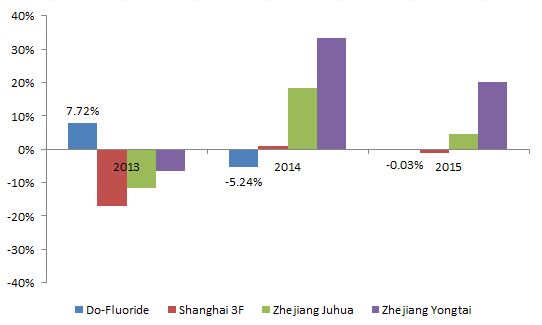
Source: Company reports & CCM
Capital maintenance and increment ratio,
2013–2015
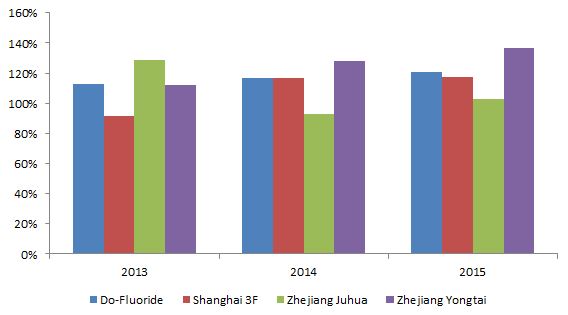
Source: Company reports & CCM
II Profit
1. Gross profit margin (fluorochemical business only)
Do-Fluoride and Zhejiang Juhua, despite small fluctuations, kept relatively
stable in gross profit margin, whilst Shanghai 3F saw a fall of 2.54 percentage
points YoY.
In particular, Shanghai 3F was the only company amongst the 4 selected ones
that suffered losses in 2015, at -USD47.63 million (-RMB307.51 million, vs.
+USD7.61 million (RMB49.14 million) in 2014). This is mainly because:
-
The demands for some knockout products declined. For instance,
the sales volume of difluorochloromethane (HCFC-22), chlorotrifluor
ethylene (CTFE) and polyvinylidene fluoride (PVDF) each fell by 9.80%,
6.08% and 0.13%
-
It was advancing the premium-oriented transformation and
capacity transfer. Specially it repositioned its 3 production bases
(Shanghai, Changshu City in Jiangsu Province and Inner Mongolia Autonomous
Region): some production equipment (for polytetrafluoro ethylene (PTFE)
for example) was suspended for reconstruction, and new projects (for
hexafluoropropylene (HFP) and 2,3,3,3-tetrafluoropropene (HFO-1234yf) for
example) were mostly under construction. All this resulted in the big
rises in administrative expenses and R&D input, by 48.47% and 34.44%
Averagely, the gross profit margin of the aforementioned 3 companies was only
15.34% (vs. averaged about 17% for domestic basic chemicals industry). This
meant that the domestic fluorochemical industry did not make satisfactory
profit, even though it was at a recovery. This can be mainly ascribed to the
severe overcapacities of mainstream products, such as hydrogen fluoride
(HF), aluminium fluoride (AlF3), fluorine-enriched refrigerants
and fluoropolymer.
Gross profit margin, 2013–2015
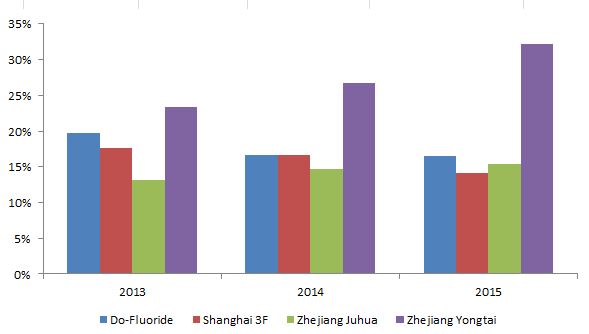
Source: Company reports & CCM
Zhejiang Yongtai outshone the other 3
companies, specifically regarding the gross profit margin, and maintained
upturns (from 23.30% to 32.20%) in 2013-2015.
This is mainly because Zhejiang Yongtai has been dedicated to the fine
fluorochemicals business and has made innovations in application (for
pharmaceuticals, pesticides and liquid crystal materials), which has brought
more opportunities to the company. Meanwhile, the company has focused on
extending and expanding the supply chain based on its advantaged products, to
continuously strengthen its competitiveness and voicing power in the market.
Accordingly:
-
Pharmaceuticals: stable sales of intermediates applicable to
sitagliptin/ moxifloxacin, and environmental impact assessment on the
intermediate for sofosbuvir passed
-
Liquid crystal materials: monomer liquid crystal product sold
at home and abroad, and color film photoresist accepted by domestic target
clients and produced at small scale
-
Pesticides: stable supplies of several ordered pesticide
intermediates; acquisition of 100% of stake in Shanghai E-Tong Chemical
Co., Ltd. to obtain large quantities of overseas registration certificates
of pesticide technical and formulations and achieve complementation of
domestic and foreign sales channels; strategic cooperation with Chongqing
Chemical & Pharmaceutical holding (Group) Company, to enrich the
product line and extend into pesticide technical and formulations
In reality, if the domestic fluorochemical companies intend to get out of the
dilemma (low gross profit margin), they should actively exploit the emerging
markets, in addition to continuing extending the supply chain and developing
premium-marketed products.
Take Do-Fluoride for example. It has marched into the Li-ion battery key
materials (such as electrolyte and cathode materials), power Li-ion battery and
alternative energy vehicle businesses, based on its lithium hexafluorophosphate
(LiPF6) production capacity layout. It aims to specifically build a
business of alternative energy, following the fast development of the said
emerging markets. According to CCM’s research, Do-Fluoride achieved a rise of
143.25% in its sales from alternative energy business in 2015. The
corresponding gross profit margin was up to 33.82%.
2. Return on common shareholders' equity (ROE) and return on total assets
(ROA)
Almost literally, Zhejiang Yongtai was in the lead, at 7.87% and 7.32%
separately. This showed its better business operation and profitability than
the other 3 companies in 2015.
Driven by the alternative energy business, Do-Fluoride also made rapid
improvements regarding the 2 indices, at 1.58% and 2.86% (vs. 0.47% and 1.81%
in 2014).
ROE and ROA, 2013–2015
|
ROE
|
|
Year
|
Do-Fluoride
|
Shanghai 3F
|
Zhejiang Juhua
|
Zhejiang Yongtai
|
|
2013
|
1.01%
|
6.24%
|
3.66%
|
1.79%
|
|
2014
|
0.47%
|
2.35%
|
2.22%
|
5.98%
|
|
2015
|
1.58%
|
-11.33%
|
2.26%
|
7.87%
|
|
ROA
|
|
Year
|
Do-Fluoride
|
Shanghai 3F
|
Zhejiang Juhua
|
Zhejiang Yongtai
|
|
2013
|
1.83%
|
5.65%
|
3.94%
|
3.28%
|
|
2014
|
1.81%
|
3.76%
|
2.70%
|
5.69%
|
|
2015
|
2.86%
|
-5.77%
|
2.78%
|
7.32%
|
Note: ROE stands for return on common shareholders' equity;
ROA stands for return on total
assets.
Source: Company reports & CCM
III Assets
1. Assets turnover (fluorochemical business only)
Except Zhejiang Juhua, the other 3 companies presented varied declines. This
manifested that Zhejiang Juhua performed fairly well in view of operating
efficiency, sales capability and assets utilisation efficiency.
The average figure of the 4 companies was only 43.26%, which to certain degree
reflected that the domestic fluorochemical industry in fact did not do a good
job in production and sales. Notably, the average figure of the petrochemical
industry was over 100%, according to statistics.
2. Receivables turnover (fluorochemical business only)
Zhejiang Juhua still maintained a relatively high level (at 1131.78%), in the
context that the 4 companies all showed falls. In light of the higher figures
given by Zhejiang Juhua, it can be concluded that the company was able to use
funds at higher efficiency and was more capable of debt repayment.
Assets turnover, 2013–2015
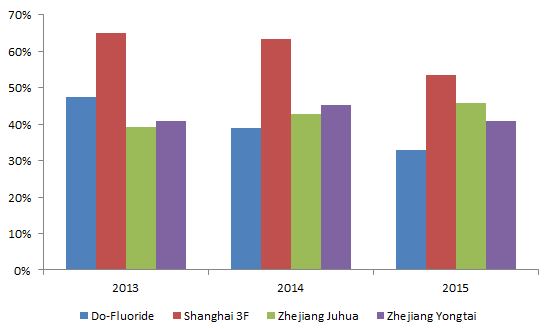
Source: Company reports & CCM
Receivables turnover, 2013–2015
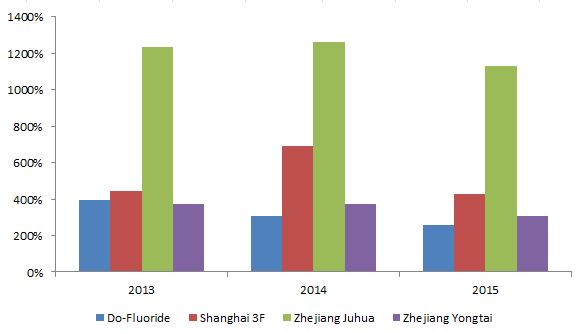
Source: Company reports & CCM
IV Debt risk
1. Balance ratio
Do-Fluoride and Shanghai 3F witnessed small falls, whilst Zhejiang Yongtai
realised a slight rise. Specifically, Zhejiang Juhua was the one holding the
lowest balance ratio, at 9.87% only.
The average figure was 17.13%. Compared to that of about 56% for the overall
chemical industry, the fluorochemical segment performed well in business
operation and risk control.
However, this also signalled that the domestic fluorochemical industry was not
active enough and still under stable operation. The ever development pattern
involving continuous production expansion and business operation under large
debts, is not applicable to the current industry. The trend to develop
“premium, refined and specialised” products should be a necessity.
2. Times of interest earned
Except Shanghai 3F of which the figure was negative due to the loss, the other
3 companies all achieved growths. This meant that the domestic fluorochemical
industry overall enhanced the capability to repay debts. Still, Zhejiang Juhua
recorded the highest level, at 8.78.
Balance ratio, 2013–2015
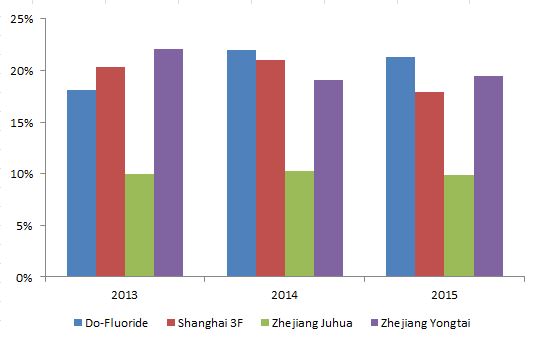
Source: Company reports & CCM
Times of interest earned, 2013–2015
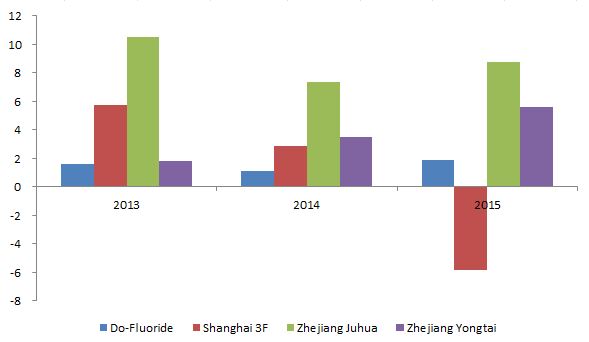
Source: Company reports & CCM
V R&D input
In light of the proportion of R&D input in revenue from fluorochemical
business, Do-Fluoride and Shanghai 3F respectively made up 4.89% and 4.68%, up
by 1.18 and 1.24 percentage points, marking leading growths in the industry.
This mainly came from their investments into downstream projects in 2015.
Though Zhejiang Yongtai presented falls, the figure at 6.07% still got a good
lead in the industry. Actually, the company should maintain the investment into
its fine fluorochemicals business which is oriented by technology, to keep the
competitiveness.
Proportion of R&D input in revenue from
fluorochemical business, 2013–2015
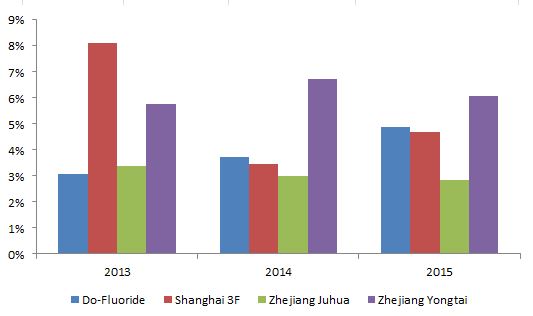
Source: Company reports & CCM
VI Key projects under construction
According to CCM’s analysis on the projects under construction:
-
Production capacity now under operation: the domestic
fluorochemical companies are mainly optimising production process, and
achieving procedure automation to cut down costs and improve economic
effects
-
Production capacity newly established: the domestic
fluorochemical companies are mainly targeting at developing premium,
deeply-processed and refined products, including new generation
fluorine-enriched refrigerants, high performance fluoropolymers, new
fluorine-enriched materials and fine fluorochemicals. Meantime, they are
stepping into emerging markets, such as the electronic chemicals, Li-ion
battery and related key materials and pharmaceutical preparations
Key projects under construction in 2015
|
Company
|
Total investment
|
Fields involved
|
Key projects under construction
|
|
Do-Fluoride
|
USD26.73 million (RMB172.58 million)
|
Inorganic fluorides, fine
fluorochemicals, and Li-ion battery and related key materials
|
Dry process high performance aluminium
fluoride (AlF3) project
|
|
Fluosilicic acid based anhydrous hydrogen
fluoride (AHF) project with white carbon black co-produced
|
|
Fine fluorochemicals project
|
|
High purity crystal lithium
hexafluorophosphate (LiPF6) project
|
|
Power Li-ion battery project
|
|
Li-ion battery separator experiment
production line project
|
|
Shanghai 3F
|
USD69.04 million (RMB445.74 million)
|
Hydrofluorocarbons (HFCs),
hydrofluoroolefins (HFOs) and fluoropolymers
|
1,1,1,2-Tetrafluoroethane (HFC-134a)
reconstruction project
|
|
2,3,3,3-Tetrafluoropropene (HFO-1234yf)
project (Phase 2)
|
|
1,1,1,4,4,4-Hexafluorobutene
(HFO-1336mzz) project
|
|
Fluoropolymer technological
reconstruction project
|
|
Tetrafluoroethylene (TFE) and
polytetrafluoro ethylene (PTFE) production expansion project
|
|
Hexafluoropropylene (HFP) project
|
|
Zhejiang Juhua
|
USD79.17 million (RMB511.18 million)
|
HFCs, fluoropolymers, new
fluorine-enriched materials and electronic chemicals
|
Pentafluoroethane (HFC-125) project
|
|
Perfluoropropane (HFC-245fa) project
|
|
Polyvinylidene fluoride (PVDF) project
|
|
LiPF6 project
|
|
Fluorinated ethylene propylene (FEP)
production expansion project
|
|
New fluorine-enriched materials project
|
|
Fluorine-enriched special gas project
|
|
High purity electronic gas project
|
|
Electronic chemicals (wet) project
|
|
Zhejiang Yongtai
|
USD24.84 million (RMB160.37 million)
|
Infrastructure, fluorine-enriched
pharmaceutical intermediates and pharmaceutical preparations
|
Office buildings
|
|
Workshop reconstruction
|
|
Mining roadway project
|
|
Shandong Zhanhua Yongtai Pharmaceutical
Co., Ltd.’s second phase project
|
|
Zhejiang Yongtai Pharmaceutical Co.,
Ltd.’s preparation workshop project
|
Source: Company reports & CCM
The article comes from China Fluoride Materials Monthly Report, 1605.
For more information about fluoride in China, go to CCM's Online Platform.
About CCM:
CCM is the
leading market intelligence provider for China’s agriculture, chemicals, food
& ingredients and life science markets. Founded in 2001, CCM offers a range
of data and content solutions, from price and trade data to industry
newsletters and customized market research reports. Our clients include
Monsanto, DuPont, Shell, Bayer, and Syngenta. CCM is a brand of Kcomber Inc.
For more information about CCM, please visit www.cnchemicals.com or get in touch with us directly by emailing econtact@cnchemicals.com or calling +86-20-37616606.